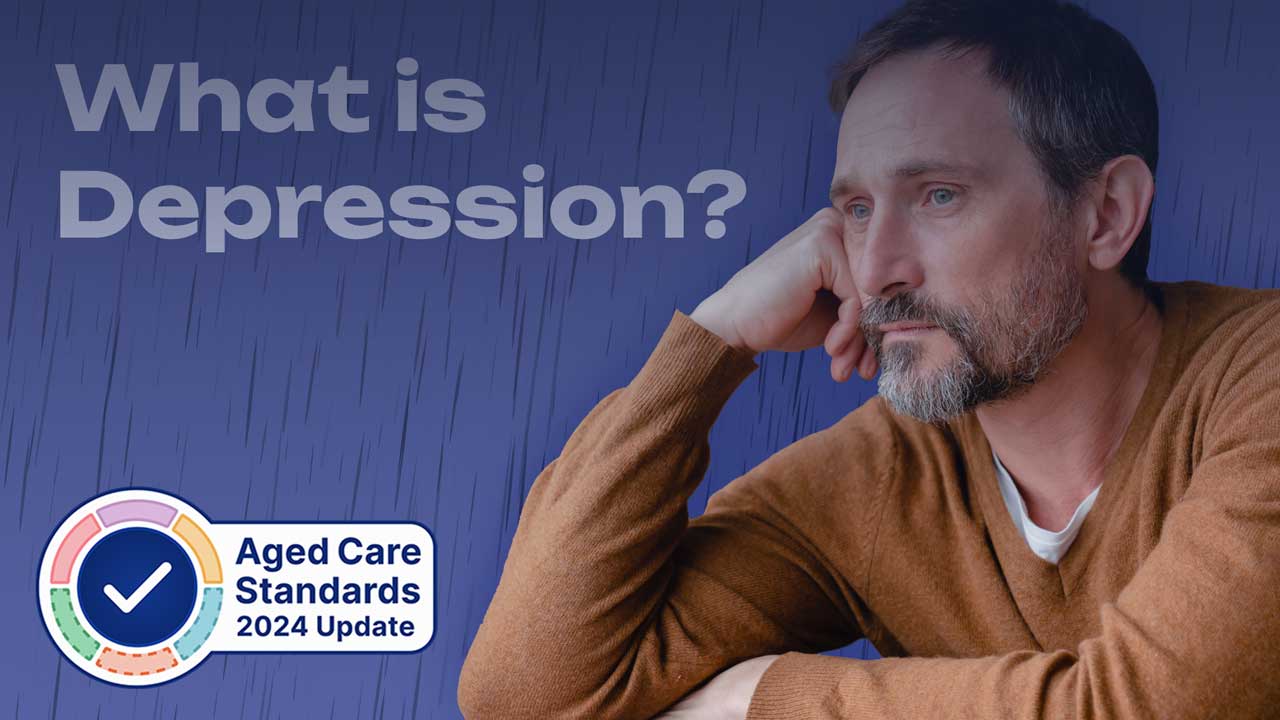What is Depression?
Published: 22 May 2024

Published: 22 May 2024

Content warning: Please be aware that this Article contains references to self-harm and suicide.
You may be alarmed to learn approximately 1.5 million Australians are currently living with depression (Beyond Blue 2024a).
And, with one in seven Australians expected to experience depression at least once in their lifetime (Beyond Blue 2024a), it is practically guaranteed that someone in your care is living with this mental illness.
Unfortunately, particularly in older populations, stigma remains around seeking help for mental illnesses. Furthermore, rates of depression among people living in residential aged care are at least 15% higher than in older people living in the community (Beyond Blue 2024a).

It’s human nature to feel down in the dumps on occasion. Depression, however, is a diagnosable medical condition that presents as feelings of intense sadness, negativity and low mood, lasting for a long period of time (APS 2018).
A characteristic of depression is that the route of the sadness is not always easy to pinpoint. Tough times can trigger a bout, but sometimes there is no obvious reason why a person may be depressed (APS 2018).
Depression is often accompanied by a range of other physical and psychological symptoms, often affecting everyday living (SANE 2023). If your low mood has become so intense that it is affecting your relationships or your work, or you are neglecting activities you once found to be simple or enjoyable, this could be a sign of depression, and help should be sought.
Standard 5: Clinical Care - Outcome 5.5: Clinical Safety under the strengthened Aged Care Quality Standards (Action 5.5.6) requires aged care providers to optimise older people’s mental health by:
(ACQSC 2024)
The term ‘depression’ is generally used to refer to ‘major depression’. However, there are several types of conditions that can be classified under the ‘depression’ umbrella.
Major depression, clinical depression or major depressive disorder is the most common form of depression and what most people mean when they think of ‘depression’. The characteristics of major depression include a low mood that is felt most days of the week and that lasts for at least two weeks (ReachOut Australia 2024a).
Melancholia is a term for a very severe depression that presents with more physical symptoms. Major characteristics of melancholia include moving slower than normal and suffering from a complete loss of pleasure in almost everything (Healthdirect 2022).
Dysthymia, also known as persistent depressive disorder, refers to a generally less severe form of major depression with longer-lasting symptoms (ReachOut Australia 2024a).
Psychotic depression is severe and is characteristically accompanied by a loss of touch with reality and episodes of psychosis, hallucinations and/or delusions (ReachOut Australia 2024a).
Perinatal depression refers to depression experienced from conception, during (antenatal depression) and after pregnancy and childbirth (postnatal depression). Perinatal depression is more than a passing ‘baby blues’ and can affect both mothers and fathers (NSW Heath 2021).
Often overlooked as a simple case of the ‘winter blues’, seasonal affective disorder (SAD) is a mood disorder that presents in a seasonal pattern. Most commonly felt in the cooler months, SAD can also occur during spring and summer (Healthdirect 2024).
Read: Assessing Depression in Dementia with the Cornell Scale
It’s important to note the overlap that often exists between depression, delirium and dementia. High rates of delirium and depression are reported in people with dementia, and conversely, dementia and depression are further risk factors for developing delirium (Health.vic 2015). You should familiarise yourself with the differences between the three conditions, as misdiagnosis is common, particularly in older people.

There are a number of factors that may contribute to depression, such as:
(Beyond Blue 2024b; SANE Australia 2023)
Though depression can be developed by anybody at any stage of life, there are some populations who are at a greater risk than others, including:
(Beyond Blue 2024a)
Signs and symptoms of depression can vary from person to person and will range from mild to very severe. One or many of the following may be felt by someone experiencing depression:
(ReachOut Australia 2024b; Beyond Blue 2024c; SANE 2023)
If any of the above symptoms are severe, last for two weeks or more and begin to affect other aspects of a person’s life, professional help should be sought (Black Dog Institute 2022).

It is important to remember that depression is treatable, just like any other illness.
A treatment plan should be person-centred and developed in collaboration with the patient to best tailor options to suit their personal circumstances (ReachOut Australia 2024b).
Treatment options may include:
(Black Dog Institute 2023; ReachOut Australia 2024b)
Timely interventions are key. Each person may respond differently to treatments, and finding the right treatment may take time. Therefore, it is important that the patient is supported through this process (ReachOut Australia 2024b).
If you suspect someone in your care is experiencing depression and has been displaying any of the signs and symptoms listed above, they should be referred to a general practitioner, mental health nurse, psychologist or psychiatrist.
If you or a person in your care expresses they are feeling suicidal, seek immediate help.
24-hour support services and counselling are available, including:
Question 1 of 3
Which one of the following is NOT a possible sign of depression?